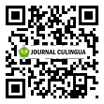ROLE OF GENDER IN PAKISTANI ELT TEXTBOOKS: A CRITICAL DISCOURSE ANALYSIS APPROACH
DOI:
https://doi.org/10.37301/culingua.v2i1.17Keywords:
Critical Discourse Analysis, ELT textbooks, Stereotype, Gender, ideologyAbstract
Language and gender relations are two ways: gender is reflected by language and language assists to shape gender. Gender is less studied in the field of textbook evaluation because it states the social standards, practices and roles that distinct females from males. Critical Discourse Studies is a persuasive framework which is applied to evaluate gender beliefs and ideologies in textbooks. It further contains the examination of ideological manipulation, hegemony, power relations and identity. The current study examines representation of gender in Pakistani English Language Teaching schoolbooks of 9th grade and 10th grade of Balochistan which is the largest province (area) of Pakistan. A mixed method approach is used to analyse the data. ‘Three-Dimensional Model’ by Fairclough (2015) which is based on description, interpretation, and explanation has been used as the theoretical framework of the study. Moreover, the description stage has analysed four aspects. These are included as the frequency of men and women presence, gender activity, the pictorial representations, and the societal/domestic roles related with them. At large scale, the cardinal ideologies roles of power-relations and social challenges are elucidated. The analysis of the two ELT textbooks reveals a gender inequality and supports males. Such inequality has led to the females being less powerful and more stereotyped.
References
Agha, N., Syed, G. K., & Mirani, D. A. (2018). Exploring the representation of gender and identity: Patriarchal and citizenship perspectives from the primary level Sindhi textbooks in Pakistan. Women’s Studies International Forum, 66, 17–24. https://doi.org/10.1016/j.wsif.2017.11.009
Ahmad, H., & Shah, R. (2014). EFL Textbooks: Exploring the Suitabilty of Textbook Contents from EFL Teachers` Perspective. VFAST Transactions on Education and Social Sciences, 5(1), 10–18. Retrieved from file:///C:/Users/gyorg/AppData/Local/Packages/Microsoft.MicrosoftEdge_8wekyb3d8bbwe/TempState/Downloads/167-911-2-PB.pdf
Al Jumiah, A. K. (2016). Language, Power, and Ideology in High School EFL Textbooks in Saudi Arabia (University of New Mexico). University of New Mexico. Retrieved from https://search.proquest.com/docview/1836796825?accountid=27931
Amerian, M., & Esmaili, F. (2015). Language and gender: A critical discourse analysis on gender representation in a series of international ELT textbooks. International Journal of Research Studies in Education, 4(2). https://doi.org/10.5861/ijrse.2014.963
Chandler, D. (1997). Children’s Understanding of What is ‘Real’ on Television: a review of the literature. Journal of Educational Media, 23(1), 65–80. https://doi.org/10.1080/1358165970230105
Dai, G. (2015). Constituting gender roles through the transitivity choice in commodity advertising - A critical discourse approach. Asian Social Science, 11(28), 58–64. https://doi.org/10.5539/ass.v11n28p58
Durrani, N. (2008). Schooling the “other”: The representation of gender and national identities in Pakistani curriculum texts. Compare, 38(5), 595–610. https://doi.org/10.1080/03057920802351374
Fairclough, N. (2001). Language and power (2nd ed.). London: Longman.
Fairclough, N. (2015). Language and power. London: Longman.
Hussain, M., Naz, A., Khan, W., Daraz, U., & Khan, Q. (2015). Gender Stereotyping in Family: An Institutionalized and Normative Mechanism in Pakhtun Society of Pakistan. SAGE Open, 5(3), 1–11. https://doi.org/10.1177/2158244015595258
Jabeen, S., Chaudhary, A. Q., & Omar, S. (2014). Gender Discrimination in Curriculum: A Reflection from Punjab Textbook Board. Bulletin of Education and Research, 36(1), 55–77.
Jannati, S. (2015). Gender Representation in EFL Textbooks?: A Case of ILI Pre-intermediate Series. Journal of Applied Linguistics and Language Research, 2(3), 211–222.
Ministry of Education. (2003). National plan of action on education for all 2001–2015. Islamabad.
Mustapha, A. S. (2013). Gender and Language Education Research: A Review. Journal of Language Teaching and Research, 4(3), 454–463. https://doi.org/10.4304/jltr.4.3.454-463
Paltridge, B. (2006). Discourse analysis: An introduction. London: Bloomsbury.
Richards, J. C. (2009). Curriculum Development in Language Teaching. In Curriculum Development in Language Teaching. Cambridge, U.K: Cambridge University Press. https://doi.org/10.1017/cbo9780511667220
Samadikhah, M., & Shahrokhi, M. (2015). A critical discourse analysis of ELT materials in gender representation: A comparison of summit and Top Notch. English Language Teaching, 8(1), 121–133. https://doi.org/10.5539/elt.v8n1p121
Spender, D. (1980). Man made language. London: Rutledge and Keegan Paul.
Sulaimani, A. (2017). Gender Representation in EFL Textbooks in Saudi Arabia: A Fair Deal? English Language Teaching, 10(6), 44–52. https://doi.org/10.5539/elt.v10n6p44
Downloads
Published
Issue
Section
License
Copyright (c) 2021 Sidra Mahmood, Surinderpal Kaur, Ali Jalalian Daghigh

This work is licensed under a Creative Commons Attribution 4.0 International License.









